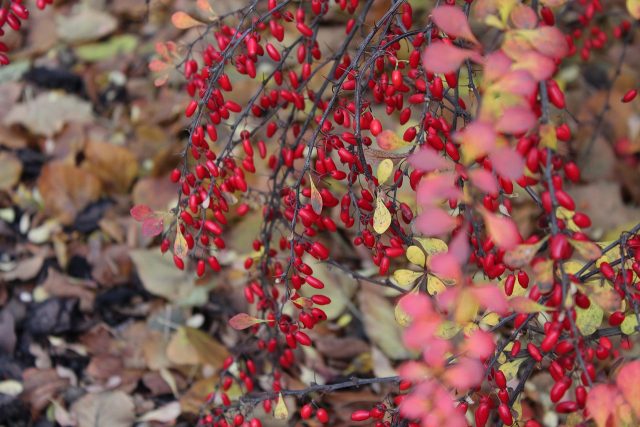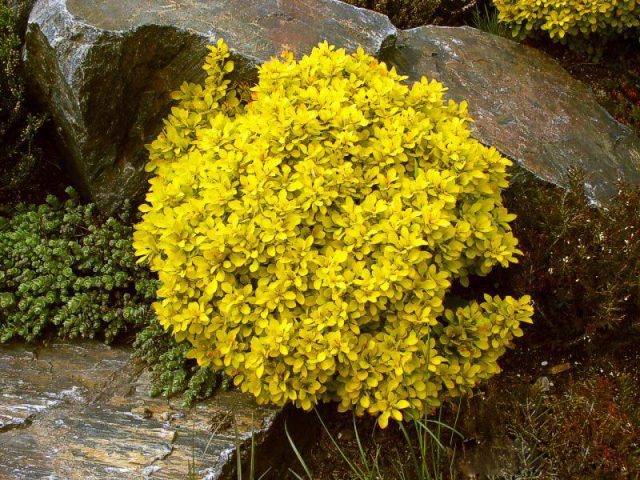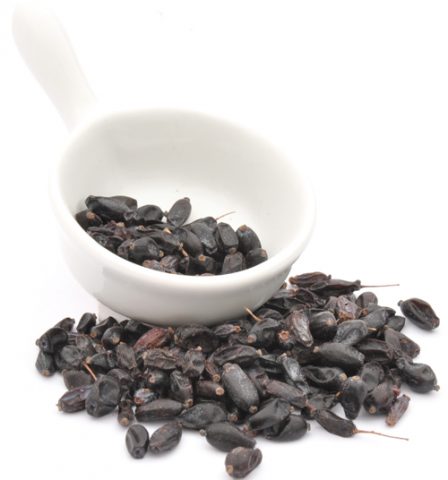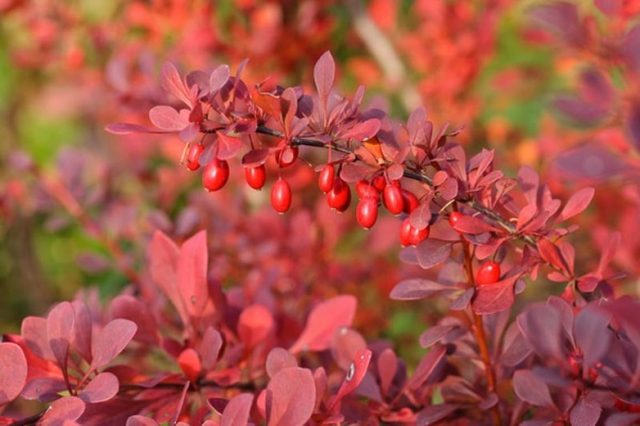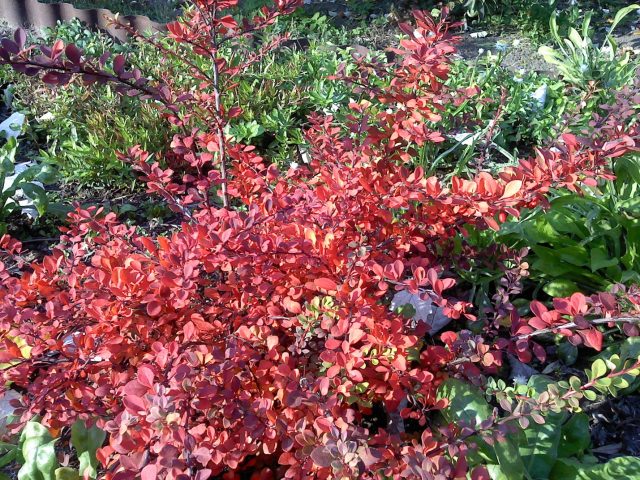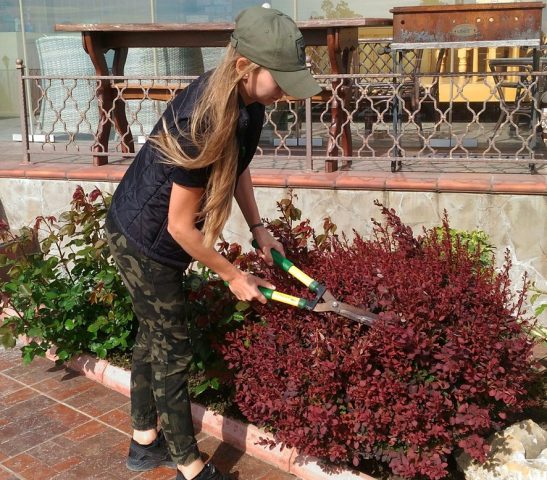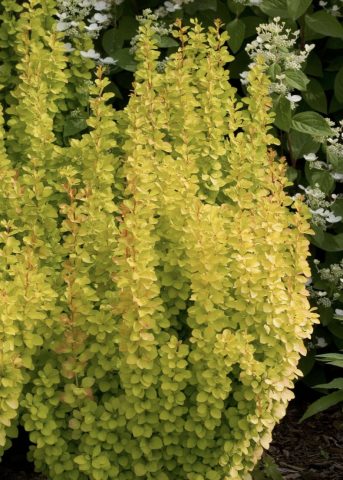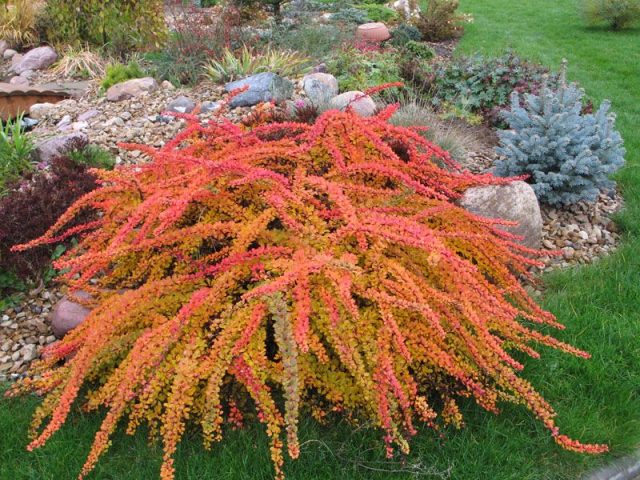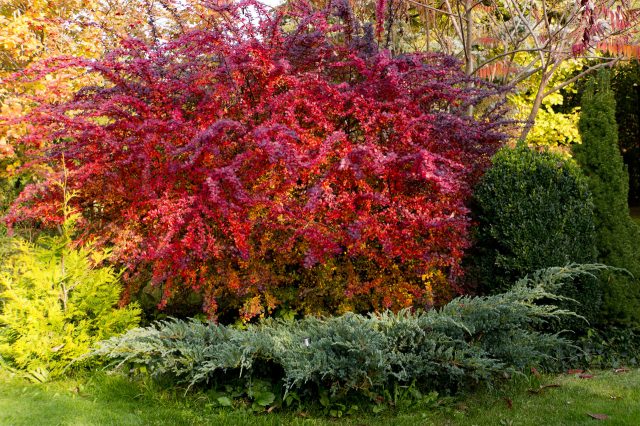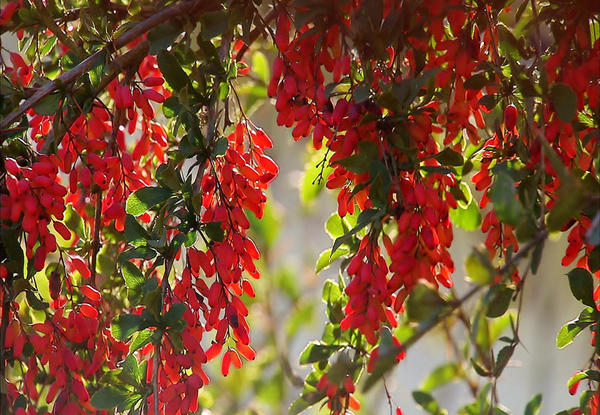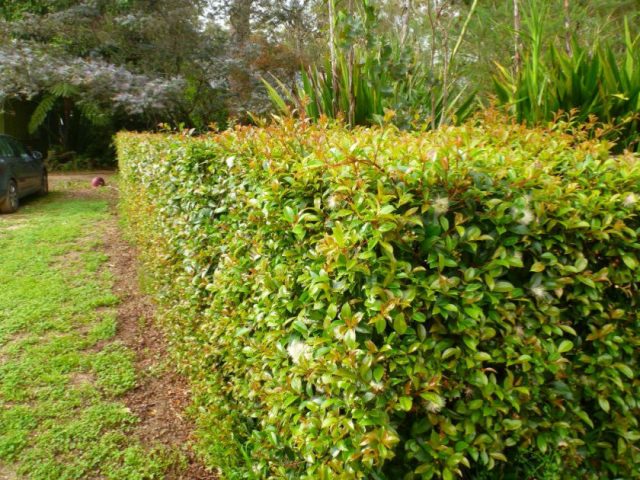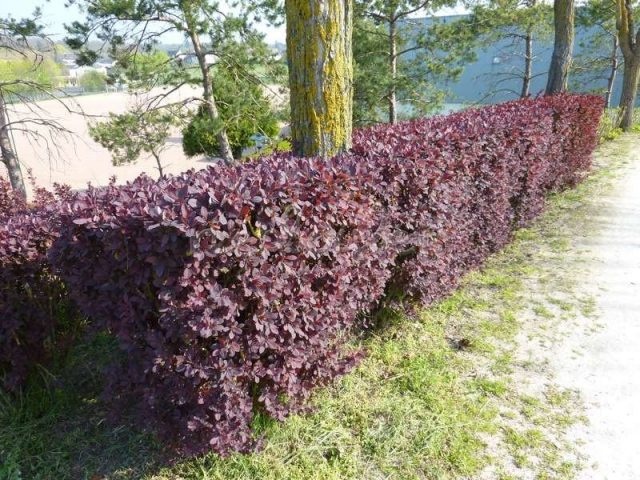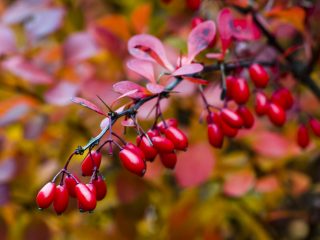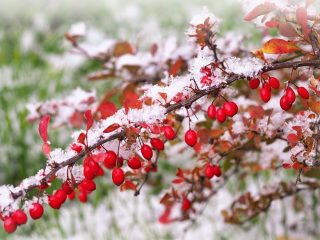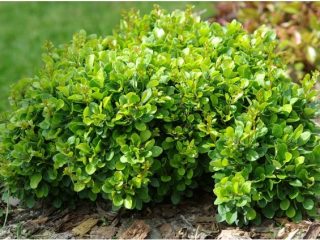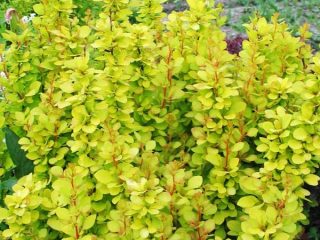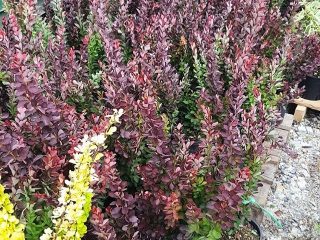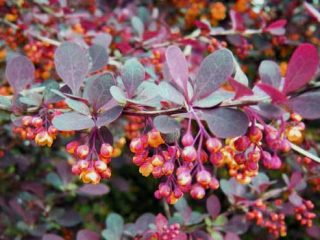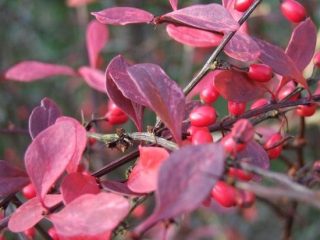Content
If you look at the varieties, photos and descriptions of Thunberg barberry, it will become clear how beautiful the shrub is. This plant will decorate the landscape design, fit perfectly into the garden, and play the role of a hedge. Today there are more than 500 species of barberry, but only a small part of this number is grown. Before you start planting a crop, it is recommended to familiarize yourself with its features in advance. This is due to the fact that not all types may be suitable for specific regions.
What does barberry look like?
Barberry is a thorny shrub that grows up to 3 m in height, depending on the variety. The root system of the plant is lignified and creeping. The bark is light brown on the outside and dark yellow on the inside.
The crown consists of spreading branches, which, in turn, are strewn with small thorns. Young shoots stand up straight, as a rule, they are yellow or yellow-purple.Leaves and thorns also grow on small shoots.
If we consider the foliage, it has the shape of an ellipse, the base is narrowed, the top can be rounded or pointed. Along the edge of the leaf there are small teeth. The length of the leaf plate is 4 cm and the width is 2 cm.
Each cluster produces 15-25 small yellow flowers. Each flower has an orange nectary, 6 petals, sepals and stamens, and 1 pistil. Flowering occurs in late spring and continues until May.
The emerging buds are small, maximum 1 cm in length. The surface is smooth, the shape is slightly pointed. In most cases, the fruits are oblong, rich red in color, and sour. Fruiting lasts from September to October.
Varieties of barberry shrubs
There is a wide variety of barberry varieties with different leaf and fruit colors. Despite such a number of species, they can be divided into several groups. Among the most famous and popular varieties, it is worth noting the following types:
- Ordinary – a shrub, up to 2 m high, that can withstand low temperatures. When barberry reaches 4 years old, the first berries appear. In this type, 3 popular varieties can be distinguished - Atropurpurea, Albovarigata, Aureomarginata;
- Canadian - barberry, growing mainly in the wild in North America. Flowering occurs in late spring. The shrub easily tolerates drought and low temperatures. If we compare visually, the Common and Canadian species are almost identical;
- Amursky – according to the description, it resembles the Common barberry, the only thing is that it grows up to 3 m in height.The berries are rich red in color and can be eaten;
- Ottawa – this variety is a hybrid. It was obtained by crossing Atropurpurea and Thunberg. The fruits are yellow, the leaves are often orange, but there are also red ones;
- Thunberg - one of the most popular and famous varieties, which is of interest not only to amateur gardeners, but also to professional landscape designers.
Before planting a specific variety, it is recommended to first study in detail the information about it and only after that start purchasing planting material.
Types and varieties of barberry shrubs
In the garden, plants create a unique atmosphere thanks to their spreading crown and variety of shades, which can vary from light lemon tones to dark burgundy flowers.
If necessary, the bush can be given any geometric shape: circle, square, bouquet. Shrubs can be used as a centerpiece or as a living fence. Some varieties have edible fruits.
Not every garden plant can boast such an abundance of species and varieties. Today there are more than 500 species, which can be giant - 3 m in height and tiny - 30-40 cm in height.
Barberry yellow
Yellow varieties of barberry have a rather bright color and a large number of red fruits. As an exception, we can cite the Alba and Luteya varieties as examples.
Lutea - ordinary barberry, reaching a height of up to 2 m. The shoots are yellow, the leaves are long (6 cm) with a pale green tint. Flowers appear in clusters. Each brush contains 20 inflorescences.Ripe fruits acquire a pale yellow color and grow up to 1 cm long.
In addition, we can distinguish species with rich, bright yellow foliage. These mainly include varieties of Thunberg barberry:
- Aurea;
- Tiny Gold;
- Maria;
- Diabolicum.
Maria - a plant with a spreading crown and thorny bushes. The level of frost resistance is average. In spring it acquires yellow foliage, which turns red and green in summer.
Barberry black
There is an Asian variety that produces black fruits after the flowering period. The bushes are quite large, on average up to 2 m in height. Flowering and fruiting occur regularly. Since the shrub is able to tolerate low temperature conditions, you don’t have to be afraid that the barberry will freeze in winter; you can cover it for the winter, but this is not necessary. The shrub has spines up to 1.5 cm long, while the fruits reach 1 cm.
Barberry red
Siberian barberry is a variety that grows in Siberia and Kazakhstan. The shrub reaches a height of up to 1 m. Flowering and fruiting occurs after the shrub is 6 years old. The flowering period is 12 days, occurs at the end of May, and in August the appearance of fruits can be observed. The berries are rich red, the foliage is green. If you need barberry with red fruits and leaves, then you can pay attention to the Ottawa species.
Barberry variegated
Variegated varieties of barberry were known at the beginning of the 20th century, but today their popularity has grown many times over. When breeding this variety, Thunberg's barberry was taken as a basis.
Among the variegated species, it is worth highlighting the Admiration variety.The shrub has an attractive appearance, grows quite slowly, the annual growth is a maximum of 4 cm, the height of an adult plant is 50 cm, the color of the leaves is unusual - red with a frame in yellow tones. During the flowering period, red-yellow flowers appear, which are replaced by rich, bright red fruits. It is important to understand that berries of this type cannot be eaten.
Barberry dwarf
The dwarf variety of barberry is often used as decorative borders. Shrubs are planted along the walls of buildings and structures or on the lawn. If we consider the most popular dwarf species by height, we can highlight:
- Atropurpurea – 30-50 cm;
- Cobolt – 50 cm;
- Bagatelle – 50 cm.
The Bagatelle variety deserves special attention. As the shrub grows, it forms a ball-shaped crown. The leaves can change color: in summer they are brown, in autumn they are a noble dark red hue.
Thunberg barberry varieties
Thunberga is a barberry with the largest number of varieties. This species is resistant to many diseases, which is why it is so popular among landscape designers.
In addition to its attractive decorative appearance, the shrub has one advantage over other species - it is easy to trim topiary. Thanks to its spreading and dense crown, the Thunberg variety is used mainly for hedges.
Kobold
Kobold is a dwarf variety of Thunberg barberry. The height of the shrub reaches a maximum of 50 cm, and about the same in width. Young shoots appear in early April and are dark brown in color. The leaves are small, length varies from 1 to 1.5 cm, ovate in shape.In spring the foliage is green and turns yellow in summer. The flowering period occurs at the beginning of May. The inflorescences are yellow with a red rim. The fruits can be red or pink. Since the berries are suitable for human consumption, they are harvested in September.
Golden Pillar
Golden Pillar is a columnar variety of barberry. The shrub is quite large, its height is 2 m, its diameter is 1 m. The color of the foliage varies depending on the season. For example, in the spring the bush is covered with yellow leaves, in the summer it acquires green tones, and in the fall it becomes a rich red hue. A distinctive feature is the ability to tolerate low temperature conditions. To prevent the bush from losing its decorative appearance, it must be planted in sunny areas.
Green Carpet
Green Carpet is a spreading and cushion-shaped variety, growing up to 50 cm in height and up to 1 m in width. This shrub has light green foliage, the crown is quite dense, and has the shape of a ball. In autumn, the shrub acquires red foliage, attracting the eye with its bright appearance. Barberry of this species is an unpretentious plant that grows well in temperate climates. The bush can be planted in group compositions with coniferous and deciduous trees, while it looks great separately on a small hill.
The best edible varieties of barberry
Some types of barberry bear edible fruits, which are rich in vitamins C. If we consider the level of productivity from 1 bush, then there have been cases when gardeners collected up to 10 kg of barberry.Red fruits are often used as spices; in addition, jam, compotes, and jellies are prepared from the berries. Varieties of edible barberry are universal shrubs, because they not only decorate a plot of land, but also give a rich harvest.
Ordinary
Common barberry is a tree-like shrub with a spreading crown. It grows in the Caucasus, Southern Europe, and Siberia. The shrub is undemanding in terms of where it grows, which is why it can often be found in places with chalk deposits and river pebbles.
A distinctive feature is the ability to withstand temperatures down to -35°C. As a rule, barberry likes to grow in sunny and dry areas. If you plant a shrub in the shade, this will greatly affect the quantity and taste of the harvest.
Amursky
The Amur variety grows in the Far East, Korea, and China. This species was first discovered by botanists on the banks of the Amur River, as a result of which the plant received its name.
It can reach a maximum height of 3.5 m, there are not many bushes, the crown is spreading with a lot of thorns. The shoots are yellow, and over time it changes to a gray-yellow hue. The color of the leaves changes depending on the season: rich green in summer, bright red in autumn. The fruits grow red in color with a shiny skin and are suitable for consumption. The harvest begins in November.
Canadian
The area of growth is the valleys and banks of rivers in North America. Abundant flowering occurs in the second half of May; the shrub is able to tolerate drought and frost.If compared visually, it has strong similarities with the ordinary species. This variety is little known to Russian gardeners, but breeders in Canada and America are actively improving the shrub. Today they want to make it decorative as much as possible, as a result of which the level of yield and taste of the fruit suffers.
spherical
The shrub can grow up to 2 m in height. During the flowering process, this species will not go unnoticed, as it emits a strong odor. It grows mainly on slopes in Central Asia, Mongolia, and western China. The fruits appear in blue-gray shades with a strong aroma. It is these berries that are used to prepare traditional dishes in Asia - lagman, pilaf.
Barberry varieties for hedges
Today, residents of Russia use about 20 decorative varieties of barberry for hedges. Only 3 of them deserve special attention:
- Ordinary;
- Ottawa;
- Thunberg.
Due to the fact that these species grow well at low temperatures, this allows them to be grown in Siberia. If you know the characteristics of each species, you can make the right choice as quickly as possible and provide the shrubs with proper care.
Ordinary
This barberry is one of the hardiest and strongest varieties. Common barberry can be used for planting in regions with harsh winters and poor soil. This type is distinguished by its unpretentiousness and decorative appearance, as a result of which it can become an excellent decoration for a plot of land. The plant reaches a height of 2.5 m, the fruits are edible.
Ottawa
The Ottawa variety was developed by breeders after crossing Atropurpurea and Common barberry. The bush first appeared in Canada. Since this species has an increased level of frost resistance, it can be grown in regions with low temperature conditions. In most cases, the shrub has purple, yellow and red colors.
Thunberg
The Thunberg variety is one of the most popular and widespread, including a large number of barberry species. The distinctive features of all available varieties are the height of the plants and the color of the foliage. The height varies from 70 cm to 1.5 m. The bright appearance and decorative nature of the plant attract gardeners and landscape designers, as a result of which Thunberg barberry is used as a hedge. The most striking is the Thunberg red-leaved barberry.
The best varieties of barberry for the Moscow region
When choosing barberry for cultivation in the Moscow region, you should pay attention to the resistance of the selected variety to low temperature conditions and the ability to grow in urban conditions. If we consider the most popular species that are ideally suited to the climatic conditions of a given area, we can highlight barberry:
- Ordinary;
- Thunberg;
- Ottawa.
To get to know each other better, you need to consider these types of barberry with their photos and names.
Alba variegata
Alba variegata is a representative of the Ordinary barberry variety. A distinctive feature of the shrub is its leaves, which have noticeable white spots. The plant can reach a height of up to 1.5 m. This species is unpretentious to the place of growth and is able to tolerate low temperatures and heat.
Superba
Superba is a variety of Ottawa barberry. The shrub is quite tall, it can grow up to 3 m. The plant is able to attract with its appearance - purple foliage. In May, the first flowers appear, having a rich yellow tint and a small red frame around the edges. In the second half of June, fruits begin to form. The berries have a rich red color and can be eaten if necessary. The advantage of this barberry is its high level of resistance to frost.
Atropurpurea
Atropurpurea - refers to the Thunberg barberry variety. Decorative bushes, small. The maximum height is 1 m. The crown has a flat-round shape. The foliage is dark purple in color, and shrubs with purple leaves can sometimes be found. In autumn, barberry is covered with bright red berries.
Conclusion
The varieties, photos and descriptions of Thunberg barberry must be studied first, and then proceed to choosing the appropriate species. Barberry has a large number of species and varieties, each of which has its own characteristics. Since the shrub is unpretentious, this allows it to be popular among gardeners. There are some species that can grow in places with temperatures down to -40°C. Plants are used for decorative purposes in gardens, hedges and landscaping.

